

* Of the nine major flyways around the world, two pass through the Yellow River Delta National Nature Reserve.
* The reserve has launched new projects and applied new technologies in recent years to restore the wetlands, recover vegetation and enhance the monitoring of birds.
* The use of technology helps reduce the impact of human activities on the natural environment and create more possibilities for biodiversity conservation.
JINAN, Nov. 21 (Xinhua) -- Early winter is a busy season for the Yellow River Delta National Nature Reserve, located in the estuary of the Yellow River in Dongying, east China's Shandong Province.
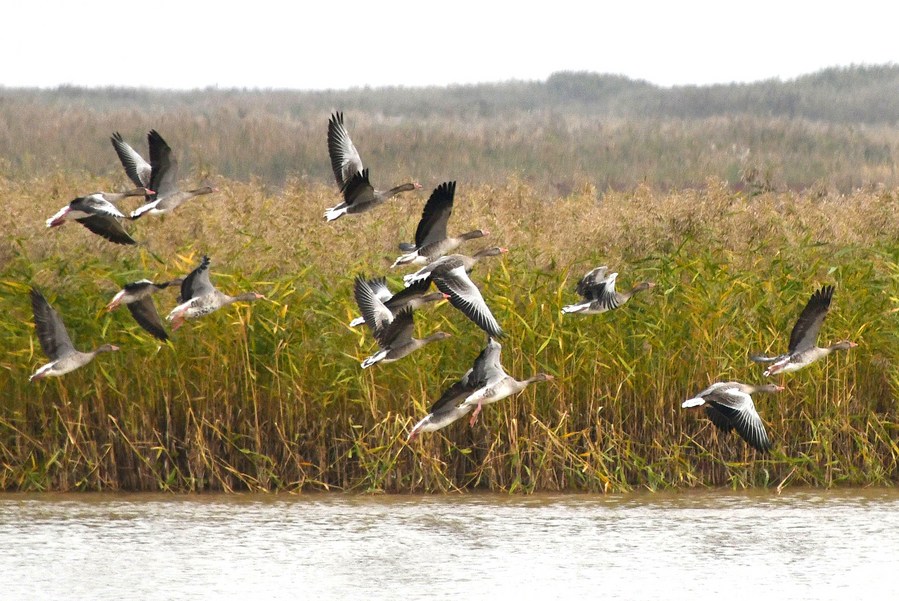
Wild birds are seen at the Yellow River Delta National Nature Reserve in Dongying, east China's Shandong Province, Oct. 12, 2023. (Xinhua/Xu Suhui)
Of the nine major flyways around the world, the East Asian-Australasian flyway and the West Pacific flyway pass through the reserve. Millions of birds make stopovers here annually, making it "an international airport" for migratory birds and a key area for their protection.
The reserve, an important wintering and stopover site for migratory birds, has launched new projects and applied new technologies in recent years to restore the wetlands, recover vegetation and enhance the monitoring of birds.
PROTECTING WETLAND
The reserve stretches for about 153,000 hectares, with wetlands making up more than 70 percent. A reliable water supply is key to the protection of wetlands and the whole ecosystem.
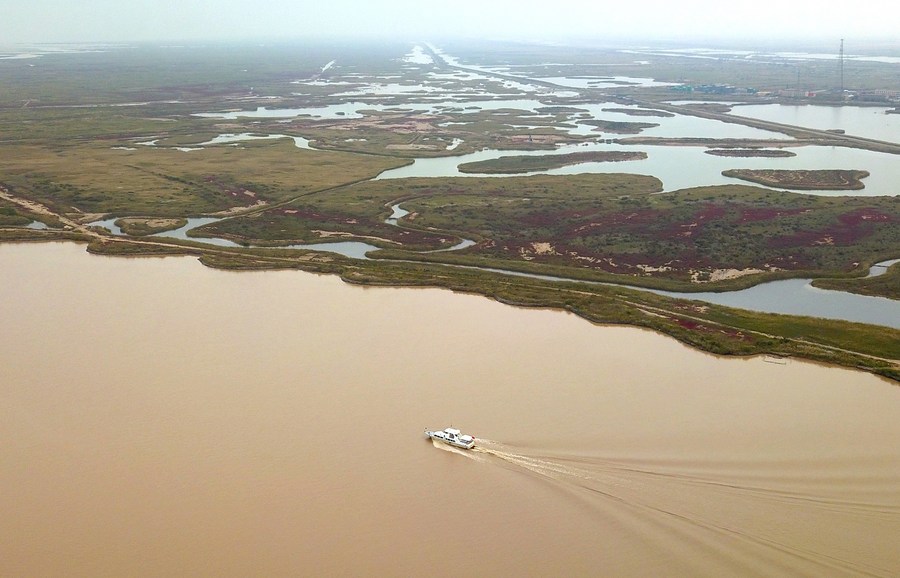
This aerial photo taken on Oct. 12, 2023 shows a view of the Yellow River Delta National Nature Reserve in Dongying, east China's Shandong Province. (Xinhua/Xu Suhui)
Over the past few years, the reserve has launched new water replenishment channels, diverting more water from the Yellow River into the reserve to restore the wetland.
The water diversion capacity has been raised from less than 40 cubic meters per second to 131 cubic meters per second, said Liu Jing, deputy director of the reserve's management committee. It has diverted 175 million cubic meters of water into the reserve in each of the past two years.
In the past, the water replenishment came once a year, before the flood season, but now it comes two or three times a year, according to demand.
"We found that in other seasons, such as spring, when animals and plants grow vigorously, a large amount of water is also required," Liu said.
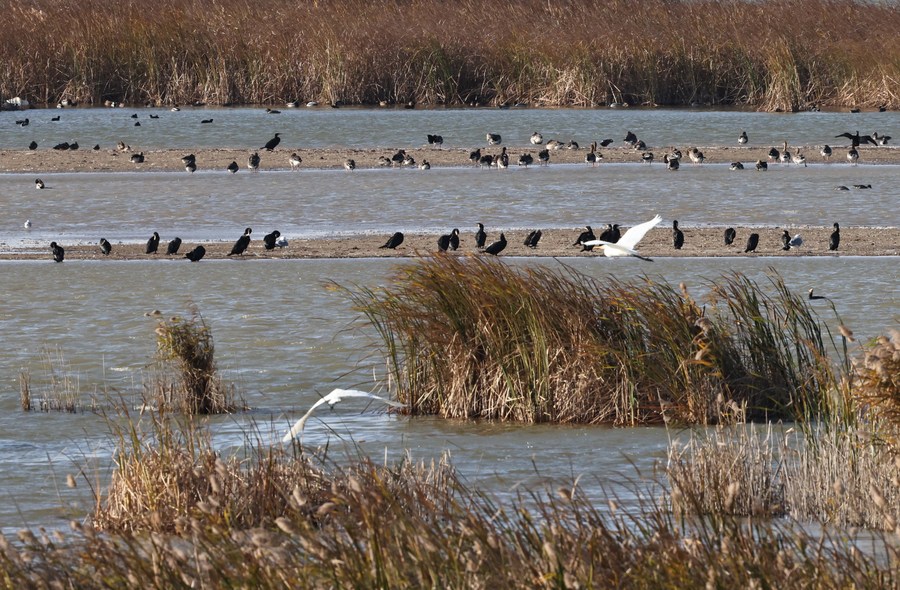
Wintering migratory birds are seen at the Yellow River Delta National Nature Reserve in Dongying, east China's Shandong Province, Nov. 12, 2023. (Xinhua/Xu Suhui)
"Water is the foundation of wetland ecosystems. Only with water can plants thrive and the wetland vegetation be restored, providing food and shelter for birds."
RESTORING VEGETATION
As the sea tide recedes, a large swathe of seagrass bed is exposed in the estuary of the Yellow River. Zhou Yi, a researcher at the Institute of Oceanology, Chinese Academy of Sciences, has engaged in seagrass bed research for more than 20 years and visits the place every other month.
The estuary was once home to the largest eelgrass bed in China, but typhoon Lekima destroyed over 660 hectares of grass bed in 2019, leaving nothing but an area of mudflat then, Zhou said.
"The seagrass bed supports benthic organisms such as small fish and crabs, nutritious food for these birds," said Zhou Licheng, the research chief with the reserve's management committee.
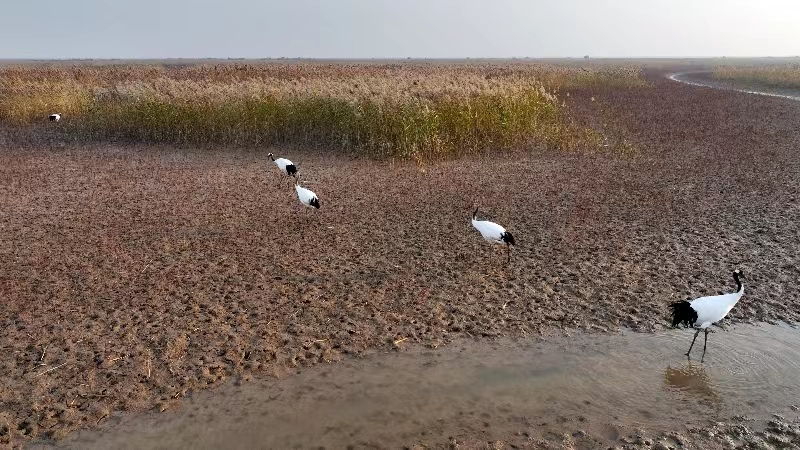
This photo taken on Nov. 15, 2023 shows red-crowned cranes foraging at the Yellow River Delta National Nature Reserve in Dongying, east China's Shandong Province. (Photo by Ren Xiaojie/Xinhua)
In collaboration with the Institute of Oceanology and the Ocean University of China, the reserve has restored nearly 100 hectares of the seagrass bed since 2022, said Zhou with the reserve.
The invasion of saltmarsh cordgrass poses a great risk to seagrass beds. The reserve conducts analysis using geographic information systems and remote sensing technology, and has eliminated 8,724 hectares of saltmarsh cordgrass through various means, according to the research chief.
The reserve's natural vegetation coverage rate now stands at 55.1 percent, making it the largest new wetland natural vegetation area along the coast of China.
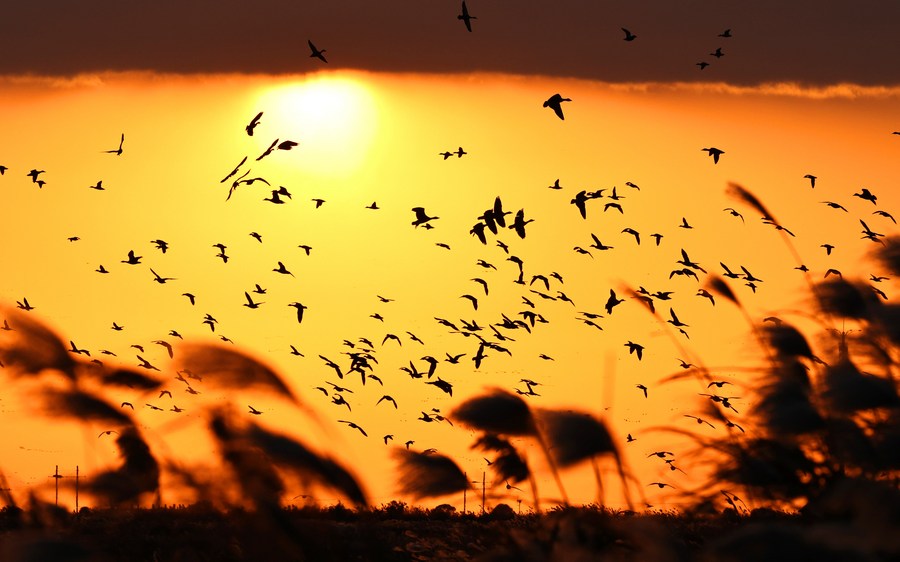
Wintering migratory birds are seen at the Yellow River Delta National Nature Reserve in Dongying, east China's Shandong Province, Nov. 12, 2023. (Xinhua/Xu Suhui)
One-third of the seagrass beds globally have disappeared due to climate change and human activities. However, step by step, China has turned the idea of planting grass on the seabed into a reality.
MONITORING NETWORK
At the Yellow River Delta Environmental Monitoring Center, Zhao Yajie, deputy director of the center, is observing the activities of an oriental white stork on a large screen. The bird is standing in an artificial nest with a diameter of about 2 meters, flipping branches to tidy up its dwelling.
This year, Zhao and her colleagues have detected 198 nests with newborn babies. The oriental stork is listed as an endangered species by the International Union for Conservation of Nature.
"We used to count birds with our own eyes," said Zhao. When she started working at the center, she would trudge through the mudflat wearing chest-high rubber waders, carrying binoculars, tripods, cameras and other equipment weighing nearly 10 kg. She would also live in remote management stations for several months at a time.
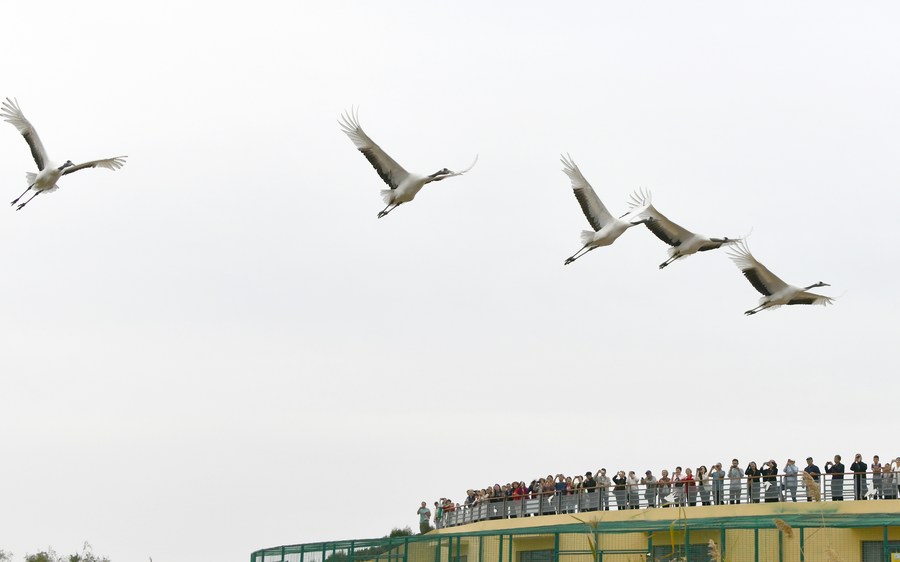
People watch red-crowned cranes at the Yellow River Delta National Nature Reserve in Dongying, east China's Shandong Province, Oct. 12, 2023. (Xinhua/Xu Suhui)
Shan Kai, a senior engineer at the reserve, said, "We first spotted a pair of oriental white storks breeding here in 2003. However, we had no idea how vigilant they were and our close-distance observation disturbed them."
In response to this issue, the reserve has built an air-ground-ocean integrated monitoring network with 66 surveillance cameras for birds, 75 for wetlands and over 40 for human activities. The network provides 24-hour real-time monitoring in key areas, using technologies such as 5G, intelligent perception and edge AI.
The network can capture and recognize birds automatically, displaying their species and health status on the screen immediately. The recognition accuracy of some key species and large birds is over 90 percent. The data will be included in the real-time statistics of bird numbers and bird activity pattern samples for the quarter.
"The use of technology helps reduce the impact of human activities on the natural environment and create more possibilities for biodiversity conservation," said Shan. "Observing without disturbing and safeguarding without over-intervention -- we see this as the greatest respect humans can show to the elves of nature."
点击右上角![]() 微信好友
微信好友
 朋友圈
朋友圈

请使用浏览器分享功能进行分享
